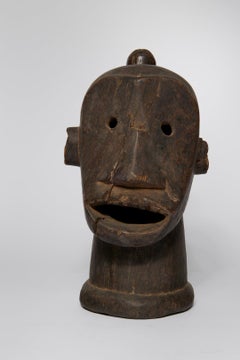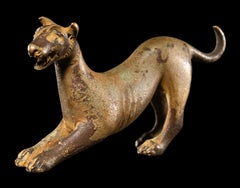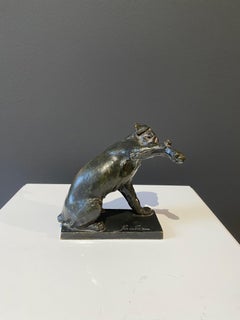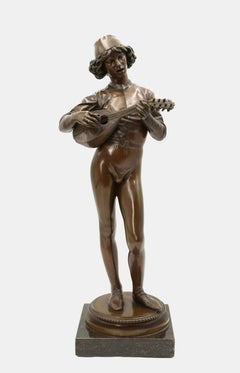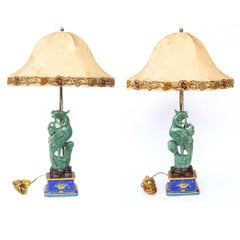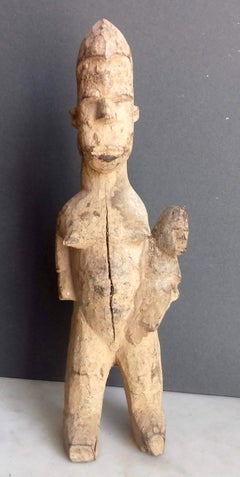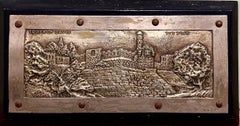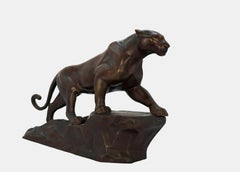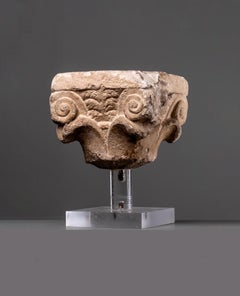Bronze More Art
to
1
3
1
1
Overall Width
to
Overall Height
to
1
1
3
1
1
2,156
297
195
177
123
105
105
68
66
62
55
54
53
53
50
48
48
47
44
42
4
3
1
1
1
1
1
3
2
Art Subject: Bronze
African Carved Wooden Makonde Initiation Ceremony Mask
Located in Beachwood, OH
African Carved Wood Makonde Mask
Heavy wood carved ceremonial mask symbolizing an ancestor
16.5 x 8 x 10 inches
A carved ceremonial mask symbolizing an ancestor, this African facial...
Category
20th Century Figurative Sculptures
Materials
Wood
ANCIENT ROMAN BRONZE SCULPTURE FIGURE OF A ROMPING DOG
Located in Milan, IT
"Roman Bronze Figure Of A Romping Dog"
Roman Empire, circa 1st Century B.C.- 1st Century A.D.
Bronze
width 7 cm
width 2 3/4 in
Provenance:
Leo Mildenberg (1913-2001) Private Collection, Zurich, prior to 1986
American Private Collection, acquired in 1991
Literature:
A.P. Kozloff, et al., More Animals in Ancient Art...
Category
15th Century and Earlier Figurative Sculptures
Materials
Bronze
Chien à la sauterelle, Sandoz, Dog, Sculpture, Bronze, Animal, 1910's
Located in Geneva, CH
Chien à la sauterelle, Sandoz, Dog, Sculpture, Bronze, Animal, 1910's
Chien à la sauterelle
Susse Fondeur
circa 1918-1930
Bronze with brown patina and shade of green
13 x 13 x 9 cm
Signed and seal of the foundry on the base : Sandoz, Susse Fondeur
Catalogue raisonné de l'oeuvre sculpté de Edouard Marcel Sandoz, sculpteur figuriste et animalier 1881-1971, by Félix Marcilhac, Les Editions de l'amateur, 1993...
Category
1910s Modern Figurative Sculptures
Materials
Bronze
Florentine singer / - The Renaissance of the Renaissance -
By Paul Dubois
Located in Berlin, DE
Paul Dubois (1829 Nogent-sur-Seine - 1905 Paris), Florentine singer, 1865. Light brown patinated bronze with cast round plinth mounted on a square marble base (3.5 cm high). Total height 53 cm. Bronze dimensions: 49.5 cm (height) x 20 cm (length) x 10 cm (width), weight 5.6 kg. Inscribed on the plinth "P.[aul] DUBOIS", dated "1865", with the foundry's mark "F. BARBEDIENNE FONDEUR" and the signet "REDUCTION MECANIQUE A. COLLAS".
- Patina very occasionally darkened, lute with loss of one tuning peg, otherwise in excellent condition.
- The renaissance of the Renaissance -
The bronze is a precisely executed and masterfully cast contemporary reduction of Paul Dubois 155 cm tall masterpiece "Florentine Singer", which is exhibited in the Musée d'Orsay and for which the artist was awarded the Medal of Honor at the Paris Salon in 1865. The work acted as a beacon, and was followed by a plethora of depictions of juveniles.
Inspired by Donatello and Luca della Robbia, but also by painters such as Piero della Francesca, Benozzo Gozzoli, and Pinturicchio, the "Florentine Singer" is not an epigonal work that pays homage to a vanished era, but a successful attempt to draw vitality from the art of the past and thus give it new life.
The effect of vitality is the core of Italian Renaissance art theory. In order to fulfill itself as art, art had to appear like nature. This naturalism also characterizes the "Florentine Singer". The young man appears to have been taken from life, which is reinforced by the momentary nature of his action. He has just struck a now fading chord. In addition, the natural appearance is enhanced by the detailed shaping of the figurative details, such as the laces with the slightly curved leather of the shoes, the belt buckle, or the ornamentation on the body of the lute. Even the fingernails are clearly defined. Unlike the Renaissance, however, the effect of liveliness here is not based on the "discovery" of nature and the human body, but primarily on the rediscovery of the art of the Quattrocento. The liveliness of the artwork is therefore at the same time a revitalization of this art, so that we can speak of a Renaissance of the Renaissance, just as the Pre-Raphaelites in England at the same time transferred the Quattrocento to contemporary art.
Dubois takes on the most difficult of all subjects, the depiction of singing through silent sculpture. He was preceded in this by Luca della Robbia and Donatello with their pulpits of singers created in the 1430s in the Museo dell'Opera del Duomo in Florence. Compared to these works, the physiognomy of Dubois singer is far less animated, yet he also depicts singing in a convincing manner. He uses the whole body. He takes the ancient contrapposto, which was essential to Renaissance sculpture, and transforms the standing leg-playing posture into a late medieval S-swing, giving the body an elegant beauty and at the same time setting it in melodic motion. In the equally elegant finger position, the music is expressed in a much more literal way with the beating of the lute. Finally, the musicality of the sculpture culminates in the face with the mouth open to sing.
Through the act of singing, which is a great challenge to the artistic will to depict perfect beauty, the gracefulness of the classical face is not diminished, but enhanced. Starting from the face with the singing mouth and the gaze absorbed by the sounds, the inner vitality spreads, giving the bronze sculpture an intense aura, enhanced by the music. Dubois transfers the beauty of the Renaissance to the musical, sublimating the visible sculpture to the invisible of music.
He took up the challenge of transcending the Renaissance with the Renaissance, thus responding to the Querelle des Anciens et des Modernes, which arose at the end of the 17th century around the French Academy and remained virulent into the 19th century, in which antiquity was regarded either as an unattainable ideal or as a standard to be surpassed. With his work, Dubois proved that the Renaissance, which had championed the art of the ancients, could lead to a new renaissance of art.
About the artist
Paul Dubois' great-uncle was the famous French Baroque sculptor Jean-Baptiste Pigalle, in whose footsteps the talented great-nephew followed. When he debuted at the Paris Salon in 1858, he signed his work "Dubois-Pigalle". At his father's request, however, he first studied law before devoting himself to sculpture under the tutelage of François Christophe Armand Toussaint in 1856 and entering the École des Beaux-Arts in 1858. From 1859 to 1863, he lived in Rome and traveled to Naples and Florence. Inspired by Florentine art of the quattrocento, Dubois initiated a school-forming neo-Florentine style that combined the elegantly simple forms of youthful grace with a precise wealth of detail.Two purchases by the French state (“envois de Rome”) were made during his stay in Rome, which brought him recognition in Paris. After his return there, he quickly became an internationally sought-after artist.
Dubois was also active as a creator of monuments. His most famous work is the equestrian statue of Joan of Arc (1896) on the forecourt of Reims Cathedral. He was also a sought-after portraitist who produced around 50 busts and - Dubois was also a passionate painter - around 100 portraits in oil.
From 1873 to 1878 he was curator of the Museum du Luxembourg, in 1876 he became a member of the Institut de France and from 1878 to 1905 he was director of the École des Beaux-Arts.
In 1865, Dubois was awarded the Paris Salon Medal of Honor for his “Florentine Singer”. In 1867 he became Chevalier, in 1874 Officier, in 1886 Commandeur of the Légion d'honneur, which awarded Dubois the Grande Croix in 1896.
Selected Bibliography
Stole, Elmar: Paul Dubois. In: Saur. Allgemeines Künstlerlexikon, vol. 30, Munich - Leipzig 2001, pp. 677-678.
GERMAN VERSION
Paul Dubois (1829 Nogent-sur-Seine - 1905 Paris), Florentinischer Sänger, 1865. Hellbraun patinierte Bronze mit gegossener runder Plinthe auf quadratischem Marmorsockel montiert (3,5 cm Höhe). Gesamthöhe 53 cm. Maße der Bronze: 49,5 cm (Höhe) x 20 cm (Länge) x 10 cm (Breite), Gewicht 5,6 kg. Auf der Plinthe mit „P.[aul] DUBOIS“ bezeichnet, auf „1865“ datiert, mit dem Gießereistempel „F. BARBEDIENNE FONDEUR“ und dem Signet „REDUCTION MECANIQUE A. COLLAS“ versehen.
- Patina sehr vereinzelt nachgedunkelt, Laute mit Verlust eines Stimmwirbels, ansonsten ausgezeichnet erhalten.
- Die Renaissance...
Category
1860s Realist Figurative Sculptures
Materials
Bronze
Pair of Chinese Lamps with Carved Aventurine Phoenixes, Jade Finials, Cloisonné
Located in Austin, TX
This gorgeous and refined pair of Asian lamps has aventurine stone carvings. The blue base of the lamp, made of cloisonné, features floral designs. ...
Category
20th Century Figurative Sculptures
Materials
Stone, Brass, Enamel
Related Items
African art tribal maternity figure, Lobi peoples Ghana - Ivory Coast
Located in Norwich, GB
A delightful African maternity figure from the Lobi peoples of the Ivory Coast/Ghana. With a serene yet feisty expression, the mother is carry...
Category
Mid-20th Century Folk Art Figurative Sculptures
Materials
Wood
H 7.88 in W 2.76 in D 2.37 in
Vintage Jerusalem Sculpture Wall Plaque 1930's Palestine Israeli Bezalel School
Located in Surfside, FL
Repousse sculptural plaque from the original Bezalel Art School in Jerusalem.
This is marked "Made in Palestine" as it is from the British Mandate period. It is in an Orientalist design of the Tower of David. marked in Hebrew and English.
Jerusalem's Bezalel School
The Bezalel Academy of Arts and Design, was founded in 1906 by Boris Schatz. In 1903, Schatz met Theodore Herzl and became an ardent Zionist. At the Zionist Congress of 1905, he proposed the idea of an art school in the Yishuv (early Jewish settlements), and in 1906 he moved to Israel and founded the Bezalel School of Art in Jerusalem. Bezalel, which was a school for crafts as well as for graphic art, became successful very rapidly. Schatz’s vision was to develop useful arts and crafts among Palestinian Jews, thereby decreasing the dependence on charity. At the same time, he sought to inspire his students to create a Jewish national style of the arts, in order to promote the Zionist endeavor. The inhabitants of 19th-century Palestine, both Jewish and non-Jewish, had produced mostly folk art, ritual objects and olive-wood and shell-work souvenirs, as well as oil painting, sculpture, tapestry and mosaics. So the founding of Bezalel provided a professional and ideological framework for the arts and crafts in Jerusalem. The school employed workers and students, of whom there were 450 in 1913, in manufacturing, chiefly for export, decorative articles ranging from cane furniture, inlaid frames and ivory and wood carvings, to damascene and silver filigree and repousse work.
A major part of Schatz’s school was the workshops, which, starting with rug-making and silversmithing, eventually offered 30 different crafts. Workshops included the "Menorah" workshop where they designed relief and souvenirs made of terra-Cotta, and the Sharar, Stanetsky and Alfred Salzmann workshops where Menorah lamps...
Category
20th Century Modern More Art
Materials
Metal
H 6 in W 11.5 in D 1 in
EDWARD BOHLIN 1920s-1930s SILVER ART PARADE SADDLE HOLLYWOOD WESTERN ARTIST VAIL
Located in San Antonio, TX
Circa Late 1920s - Early 1930s. It is all Bohlin made and marked to include the saddle, the headstall and the breast collar. All made in Hollywood California. The only non-Bohlin ite...
Category
1930s Realist More Art
Materials
Silver
Joubana, Bronze, by Modern Indian Master Artist Lalu Prasad Shaw "In Stock"
Located in Kolkata, West Bengal
Lalu Prasad Shaw - Joubana - 27 x 21 x 18 inches (unframed size)
Bronze, Edition-5.
Style : Known widely for his highly stylized portraits of Bengali women and couples, Lalu Prasad ...
Category
2010s Modern Figurative Sculptures
Materials
Bronze
Picador, A.R. 200
Located in Palo Alto, CA
Created in 1953, ceramic Picador A.R. 200 is a round plate of white earthenware clay with oxidized paraffin decoration (brown, green, white) in a stanniferous enamel bath...
Category
1950s Abstract Figurative Sculptures
Materials
Enamel
Kate board - skateboard - Grayson Perry
Located in London, GB
Grayson Perry
Kate Board, 2017
Screenprint on skateboard
Made of 7-ply Grade A Canadian Maple wood
31 1/2 × 7 9/10 in 80 × 20 cm
Edition of 999
co-published by the artist and The Sk...
Category
2010s Contemporary More Art
Materials
Wood, Screen
"Untitled, Joyride" miniature diorama
Located in Philadelphia, PA
"Untied, Joyride" is an original metal, fabric, pebbles, wire, polyester fibre, plastic, paper, and enamel paint artwork by Kendal Murray measuring appro...
Category
2010s Contemporary Figurative Sculptures
Materials
Metal, Enamel, Wire
Guatemala. Maschera di Baila de la Conquista. Inizio XX secolo
Located in Firenze, IT
Questa maschera guatemalteca del inizio del XX secolo, scolpita in legno e utilizzata per la danza della Riconquista (Baila de la Conquista) , raffigura vividamente un uomo europeo, ...
Category
Early 20th Century Folk Art Figurative Sculptures
Materials
Wood, Intaglio
Waiting For His Lover, Paul Moore bronze sculpture, Native American Flute
By Paul Moore
Located in Santa Fe, NM
Waiting For His Lover, Paul Moore bronze sculpture, Native American Flute
Outdoor or indoor life size bronze sculpture
Paul Moore
WAITING FOR HIS L...
Category
1990s Contemporary Figurative Sculptures
Materials
Bronze
H 64 in W 25 in D 21 in
Peacock Brass and Agate Sculpture on Black Marble Base Attributed to Willy Daro
Located in Clermont-Ferrand, Auvergne-Rhône-Alpes
This amazing sculpture figures a peacock making the wheel. Each feather is made of a slice of transparent agate, soldered with brass to the rest of the wheel. The agate wheel is me...
Category
1970s Other Art Style More Art
Materials
Marble, Brass
H 16.15 in W 17.92 in D 7.88 in
The Kiss
Located in Troy, NY
This sculptural head is made in Haiti from mahogany wood. The wood has a worn, dark brown patina. The carving is somewhat minimalistic, thus giving a modern twist to a tribal gesture...
Category
1950s Tribal Figurative Sculptures
Materials
Mahogany
Día de Muertos Traditions
Located in Mexico City, MX
The two artists were inspired by Mexican the Day of the Dead Tradition and folklore represented on the famous "papel picado" which decorates all the beaut...
Category
2010s Contemporary Figurative Sculptures
Materials
Sandstone
Previously Available Items
Panther striding upwards / - The powerful elegance of animalism -
Located in Berlin, DE
Arthur Dupagne (1895 Liège - 1961 Woluwe-Saint-Pierre), Panther striding upwards, c. 1938. Patinated bronze in full cast on a hollow-cast terrain base, signed in the cast “Dupagne”, 22 cm (length) x 13.5 cm (height) x 6 cm (width), 1.35 kg.
- Patina somewhat rubbed, slightly bumped in places, in good overall condition.
- The powerful elegance of animalism -
The powerful panther strides up a rock formation and pauses at the edge, overhanging it with his left paw to peer into the distance. He seems to be surveying his territory and searching for prey at the same time. Even if the predator pauses, the impulse to move upward may continue with a mighty leap the next moment; after all, the panther seems to have already caught the scent and made visual contact.
The staircase-like rock formation shows the panther's strength, which is present down to the tip of its tail, in the elegance of its supple, powerful movement. Arthur Dupagne certainly studied these movements in nature, and yet he formulates the musculature in the geometricized language of Art Deco. This does not transform the panther into an abstract creature of art, but rather expresses the fullness of power and the exciting dynamics of its inner movement. Dupagne also transferred the artistic experience he had gained in the Congo of a powerful, original African art...
Category
1930s Art Deco Figurative Sculptures
Materials
Bronze
H 5.32 in W 8.67 in D 2.37 in
ITALIAN MEDIEVAL CAPITAL, 12th/13th Century
Located in Milan, IT
ITALIAN MEDIEVAL CAPITAL
Italy, 12th/13th Century
marble
19 x 23 x 23 cm
7 1/2 x 9 x 9 in
total height 31 cm (12 1/4 in)
Category
15th Century and Earlier Figurative Sculptures
Materials
Marble
Patinated Cast Bronze of a Horse
Located in Milford, NH
A fine limited edition cast bronze of a horse by Albanian Sculptor Thanas Papa (20th c). Papa was from the village of Paftal in Berat, Albania, graduated from Jordan Misja High Scho...
Category
1990s Figurative Sculptures
Materials
Bronze
Chauve souris aux ailes déployées, Giacometti, animal, Bronze, sculpture, design
Located in Geneva, CH
Chauve souris aux ailes déployées, Giacometti, animal, Bronze, sculpture, design
Chauve souris aux ailes déployées
Foundry Lucien Thinot
Bronze with brown patina
8.3 x 7.5 x 4 cm
We...
Category
Late 20th Century Figurative Sculptures
Materials
Bronze
H 3.27 in W 2.96 in D 1.58 in
